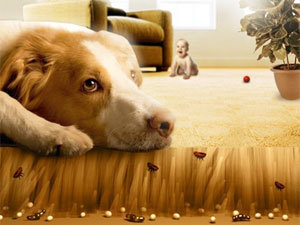Hendren’s Helpful Hints – Let’s Talk About Fleas, Baby!


Today I would like to talk about a subject that has really been bugging me…and your pets. FLEAS!! There are a ton of misconceptions about fleas out there, and today I would like to clear some of them up. The best way I can think of to debunk some myths is to address them head-on. However, in order to do that I think you need to have a good grasp of the flea life cycle, so here is a simple breakdown.
The most common flea is Ctenocephalides felis, or the “cat flea.” It’s the most common ectoparasite (parasite that lives on the outside of its host) of dogs and cats in North America. Don’t be fooled! Just because it’s the cat flea doesn’t mean it’s only on cats. This flea is found on all kinds of mammals and even birds. So all those little furry creatures in your backyard can be sources of infestation.
When a flea finds its way onto your pet, they have two things in mind: feed and procreate. (Think of your pet like a mobile singles’ bar for fleas). They lay their eggs on your pet and within a few hours the eggs will readily fall off into the environment. I love to use the phrase “flea egg salt shaker” because that is exactly how the eggs are spread throughout your home.
If the conditions are right, the eggs develop into larvae, also known as maggots. Maggots develop well in cool, shady areas of your yard, or in undisturbed areas of your house. Carpets, baseboards, hardwood, underneath your couch cushions, in the dog or cat bed, on your comforter—none of these areas are safe from flea maggots if a pet with fleas has access to them. Fun fact – these maggots not only eat feces from adult fleas, but they also eat organic debris, flea egg shells, and OTHER maggots! So if your pet has fleas you probably have cannibal maggots living in your home with you. Gross, right?
The next life cycle stage is the pupa stage. This is kind of like a cocoon. I dislike this part of the life cycle the most simply because there is NOTHING that will kill the cocoon. These creatures can stay in the cocoon for 14 days up to 30 weeks. They emerge when they sense increased temperature, carbon dioxide, or mechanical pressure (all things contributed by breathing, moving, blood-filled life forms). Once they emerge as adults, they start looking for another host and the life cycle comes full circle. A word you should know is BIOMASS – these are all the life stages that occur off your pet in the environment. Because one female flea can lay 40 to 50 eggs in a day, the biomass greatly exceeds the number of fleas on your pet. This is an extremely important concept when it comes to clearing your home of a flea infestation.

Now that you understand the flea life cycle, let’s get down to addressing the truth behind some common misinformation about flea prevention and control.
- I can use essential oils to prevent fleas on my pet.
Well…you can use them, but the level of prevention is certainly not on par with the fantastic products that are available today. Many of these oils – lavender, rosemary, eucalyptus—are only effective for as long as they smell (a couple of hours), and they don’t kill the fleas, they just repel them. So you still have the biomass in the environment to worry about. In addition, the concentrations necessary for the oils to work can build up in your pet’s skin over time, and can cause toxicity. I also try to think: What if I had a super sniffer like a dog or cat? That concentrated scent would probably be very irritating!
- Diatomaceous Earth kills fleas in the environment.
Again, it may kill some fleas, but it won’t rid your home of infestation. There are additional concerns with it being in a powder form – it is harmful for your pet (or you) to inhale this product. Many of the products available from a veterinarian have excellent residual kill times. This means that the product you put in or on your pet will kill fleas in the environment for a period of time – some can work for months!
- Raw diets prevent fleas.
No. Just…no.
- I don’t see fleas on my pet, so my pet doesn’t have fleas.
Ok. So you know how you and I have opposable thumbs and we can scratch an itch with our dexterous hands? Dogs and cats can use their feet to scratch some, but they frequently also use…their mouths! That’s right, folks, your pet (especially your cat) is most likely ingesting the fleas they “scratch” with their teeth. I was recently at a dermatology lecture, and the specialist told us that seeing TWO fleas on a cat represents a HEAVY flea burden because cats are so good at grooming themselves. If your pet is extremely itchy, has hair loss around the tail head and down the back legs, and you aren’t using a recommended flea preventive once a month then it’s fleas until proven otherwise. There’s a word for people who just won’t believe their pet has fleas: “Flea-nial.” Trust me! Having a pet with fleas doesn’t mean you’re a bad pet owner, and it doesn’t mean there’s anything wrong with your housekeeping skills. Fleas are extremely smart little creatures and they can overwhelm a household in a short period of time if all the pets in the family aren’t on consistent prevention.
- My pet doesn’t go outside, so she can’t get fleas.
Your pet may not go outside…but YOU do! Fleas can hitch a ride on the cuffs of your pants, socks, or shoes and enter your home. No home is a bubble, and because of this we recommend flea prevention even for indoor-only pets.
- I don’t see fleas on me, so we don’t have fleas.
Apologies in advance to any vegetarians for this metaphor: to a flea you are hamburger, your pet is filet mignon. Of course the flea will feed on you, but if there’s a pet around they will preferentially feed from your animals. Rumor has it that this is why so many royal families of the past surrounded themselves with dogs – to keep the fleas away from themselves!
- But I’m using a flea collar.
Flea collars pretty much only kill the fleas around a pet’s neck. The exception to this rule is the Seresto collar, which works very well – just understand that if your pet goes swimming or the collar gets wet frequently you’ll need to replace it much sooner than what is suggested on the box.
- But I use a flea shampoo.
Like many of the aforementioned products, this will kill the fleas currently on your pet – but it doesn’t touch the biomass. Not to mention that the detergents in these shampoos can be very harsh and can’t be used daily.
The gold standard for treatment and prevention of fleas is to use a veterinarian-recommended product. Again, many of these products will kill fleas in the environment over time. You can decide if an oral medication (by mouth) or a topical product (on the skin) works best for you. I personally prefer the oral products because you know a bath or a swim won’t potentially hurt efficacy. I also recommend YEAR-ROUND prevention as we don’t get quite cold enough to completely kill fleas in the winter.
If you currently have an infestation in your home your pet needs to be on prevention for at least 6 months – remember how the cocoon stage can stay dormant for up to 30 weeks? Six months of prevention will make sure to kill any late-erupting adults. The best way to treat your home is to vacuum. Place a flea collar in the canister or bag before you start. Even if you have hardwood floors, vacuum once a day for at least 2 weeks. Make sure to vacuum underneath couch cushions or any areas where your pet likes to rest for extended periods of time. Any dog/cat bedding should be run through a washing machine – hot, soapy water will kill any eggs. If you have a pet that shares the bed with you, I recommend taking your comforter to the laundromat or running it through your washer at home if you can.
I hope this answers any questions you may have – and if you are starting to feel a crawling sensation on your skin then it may be time to bring your pet to see us at Compassionate Care!
Here’s to Happy, Healthy Pets!
Dr. Lauren Hendren
Sources:
http://www.capcvet.org/capc-recommendations/fleas
More Information:
http://www.capcvet.org/ (Companion Animal Parasite Council website)
http://www.veterinarypartner.com/Content.plx?P=A&S=0&C=0&A=3237 (Veterinary Partner article “Fleas: Know Your Enemy”)
http://www.merckvetmanual.com/mvm/integumentary_system/fleas_and_flea_allergy_dermatitis/overview_of_fleas_and_flea_allergy_dermatitis.html (The Merck Veterinary Manual website)
